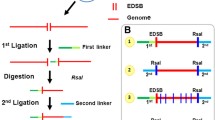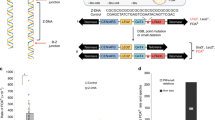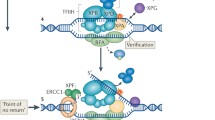Abstract
8-Hydroxyguanine (7,8-dihydro-8-oxoguanine: oh8Gua) is a damaged form of guanine induced by oxygen-free radicals and causes GC to TA transversions. Previously we isolated the hOGG1 gene, a human homolog of the yeast OGG1 gene, which encodes a DNA glycosylase and lyase to excise oh8Gua in DNA. In this study, we isolated a mouse homolog (Ogg1) of the OGG1 gene, characterized oh8Gua-specific DNA glycosylase/AP lyase activities of its product, and determined chromosomal localization and exon-intron organization of this gene. A predicted protein possessed five domains homologous to human and yeast OGG1 proteins. Helix-hairpin-helix and C2H2 zinc finger-like DNA-binding motifs found in human and yeast OGG1 proteins were also retained in mouse Ogg1 protein. The properties of a GST fusion protein were identical to human and yeast OGG1 proteins in glycosylase/lyase activities, their substrate specificities, and suppressive activities against the spontaneous mutagenesis of an Escherichia coli mutM mutY double mutant. The mouse Ogg1 gene was mapped to Chromosome (Chr) 6, and consisted of 7 exons approximately 6 kb long. Two DNA-binding motifs were encoded in exons 4 through 5. These data will facilitate the investigation of the OGG1 gene to elucidate the relationship between oxidative DNA damage and carcinogenesis.
Similar content being viewed by others
References
Aburatani H, Hippo Y, Ishida T, Takashima R, Matsuba C, Kodama T, Takao M, Yasui A, Yamamoto K, Asano M, Fukasawa K, Yoshinari T, Inoue H, Ohtsuka E, Nishimura S (1997) Cloning and characterization of mammalian 8-hydroxyguanine-specific DNA glycosylase/apurinic, apyrimidinic lyase, a functional mutM homologue. Cancer Res 57, 2151–2156
Ames BN (1983) Dietary carcinogens and anticarcinogens. Science 221, 1256–1264
Ames BN, Gold LS, Willett WC (1995) The causes and prevention of cancer. Proc Natl Acad Sci USA 92, 5258–5265
Arai K, Morishita K, Shinmura K, Kohno T, Kim S-R, Nohmi T, Taniwaki S, Ohwada S, Yokota, J (1997) Cloning of a human homolog of the yeast OGG1 gene that is involved in the repair of oxidative DNA damage. Oncogene 14, 2857–2861
Au KG, Clark S, Miller JH, Modrich P (1989) Escherichia coli mutY gene encodes an adenine glycosylase active on G-A mispairs. Proc Natl Acad Sci USA 86, 8877–8881
Boiteux S, Gajewski E, Laval J, Dizdaroglu M (1992) Substrate specificity of the Escherichia coli Fpg protein (formamidopyrimidine-DNA glycosylase): excision of purine lesions in DNA produced by ionizing radiation or photosensitization. Biochemistry 31, 106–110
Breimer LH (1990) Molecular mechanisms of oxygen radical carcinogenesis and mutagenesis: the role of DNA base damage. Mol Carcinog 3, 188–197
Cheng KC, Cahill DS, Kasai H, Nishimura S, Loeb LA (1992) 8-Hydroxyguanine, an abundant form of oxidative DNA damage, causes G → T and A → C substitutions. J Biol Chem 267, 166–172
Copeland NG, Jenkins NA, Gilbert DJ, Eppig JT, Maltais LJ, Miller JC, Dietrich WF, Weaver A, Lincoln SE, Steen RG, Stein LD, Nadeau JH, Lander ES (1993) A genetic linkage map of the mouse: current applications and future prospects. Science 262, 57–66
Davisson MT (1994) Rules and guidelines for genetic nomenclature in mice. Mouse Genome 92, 7–32
Floyd RA (1990) The role of 8-hydroxyguanine in carcinogenesis. Carcinogenesis 11, 1447–1450
Grollman AP, Moriya M (1993) Mutagenesis by 8-oxoguanine: an enemy within. Trends Genet 9, 246–249
Hayashizaki Y, Hirotsune S, Okazaki Y, Shibata H, Akasako A, Muramatsu M, Kawai T, Watanabe S, Shiroishi T, Moriwaki K, Taylor B, Matsuda Y, Elliott RW, Manly KF, Chapman VM (1994) A genetic linkage map of the mouse using restriction landmark genomic scanning (RLGS). Genetics 138, 1207–1238
Kasai H, Nishimura S (1991) Formation of 8-hydroxyguanosine in DNA by oxygen radicals and its biological significance. In Oxidative Stress: Oxidants and Antioxidants, H. Sies, ed.: (Academic Press), pp 99–116
Labahn J, Scharer OD, Long A, Ezaz-Nikpay K, Verdine GL, Ellenberger TE (1996) Structural basis for the excision repair of alkylation-damaged DNA. Cell 86, 321–329
Lu R, Nash HM, Verdine GL (1997) A mammalian DNA repair enzyme that excises oxidatively damaged guanines maps to locus frequently lost in lung cancer. Curr Biol 7, 397–407
Maki H, Sekiguchi M (1992) MutT protein specifically hydrolyses a potent mutagenic substrate for DNA synthesis. Nature 355, 273–275
Manly KF, Elliott RW (1991) RI manager, a microcomputer program for analysis of data from recombinant ingred strains. Mamm Genome 1, 123–126
Michaels ML, Miller JH (1992) The GO system protects organisms from the mutagenic effect of the spontaneous lesion 8-hydroxyguanine (7,8-dihydro-8-oxoguanine). J Bacteriol 174, 6321–6325
Michaels ML, Pham L, Cruz C, Miller JH (1991) MutM, a protein that prevent G: C → T: A transversions, is formamidipopyrimidine-DNA glycosilase. Nucleic Acids Res 19, 3629–3632
Michaels ML, Cruz C, Grollman AP, Miller JH (1992) Evidence that MutY and MutM combine to prevent mutations by oxidatively damaged form of guanine in DNA. Proc Natl Acad Sci USA 89, 7022–7025
Moriya M, Ou C, Bodepudi V, Johnson F, Takeshita M, Grollman AP (1991) Site-specific mutagenesis using a gapped duplex vector: a study of translesion synthesis past 8-oxodeoxyguanosine in E. coli. Mutat Res 254, 281–288
Nagashima M, Sasaki A, Morishita K, Takenoshita S, Nagamachi Y, Kasai H, Yokota J (1997) Presence of human cellular protein(s) that specifically binds and cleaves 8-hydroxyguanine containing DNA. Mutat Res 383, 49–59
Nash HM, Bruner SD, Scharer OD, Kawate T, Addona TA, Spooner E, Lane WS, Verdine GL (1996) Cloning of a yeast 8-oxoguanine DNA glycosylase reveals the existence of a base-excision DNA-repair protein superfamily. Curr Biol 6, 968–980
O’Connor TR, Laval J (1989) Physical association of the 2,6-diamino-4-hydroxy-5N-formamidopyrimidine-DNA glycosylase of Escherichia coli and an activity nicking DNA at apurinic/apyrimidinic site. Proc Natl Acad Sci USA 86, 5222–5226
Rosenquist TA, Zharkov DO, Grollman AP (1997) Cloning and characterization of a mammalian 8-oxoguanine DNA glycosylase. Proc Natl Acad Sci USA 94, 7429–7434
Shibutani S, Takeshita M, Grollman AP (1991) Insertion of specific bases during DNA synthesis past the oxidation-damaged base 8-oxodG. Nature 349, 431–434
Shinmura K, Kasai H, Sasaki A, Sugimura H, Yokota J (1997) 8-Hydroxyguanine (7,8-dihydro-8-oxoguanine) DNA glycosylase and AP lyase activities of hOGG1 protein and their substrate specificity. Mutat Res, in press
Suzuki M, Matsui K, Yamada M, Kasai H, Sofuni T, Nohmi T (1997) Construction of mutants of Salmonella typhimurium deficient in 8-hydroxyguanine DNA glycosylase and their sensitivity to oxidative mutagens and nitro compounds. Mutat Res, in press
Tani M, Shindo-Okada N, Hashimoto Y, Shiroishi T, Takenoshita S, Nagamachi Y, Yokota J (1997) Isolation of a novel Sry-related gene that is expressed in high-metastatic K-1735 murine melanoma cells. Genomics 39, 30–37
Tchou J, Kasai H, Shibutani S, Chung MH, Laval J, Grollman ANS (1991) 8-Oxoguanine (8-hydroxyguanine) DNA glycosylase and its substrate specificity. Proc Natl Acad Sci USA 88, 4690–4694
Thayer MM, Ahern H, Xing D, Cunningham RP, Tainer JA (1995) Novel DNA binding motifs in the DNA repair enzyme endonuclease III crystal structure. EMBO J 14, 4108–4120
Totter JR (1980) Spontaneous cancer and its possible relationship to oxygen metabolism. Proc Natl Acad Sci USA 77, 1763–1767
van der Kemp PA, Thomas D, Barbey R, de Oliveira R, Boiteux S (1996) Cloning and expression in Escherichia coli of the OGG1 gene of Saccharomyces cerevisiae, which codes for a DNA glycosylase that excises 7,8-dihydro-8-oxoguanine and 2,6-diamino-4-hydroxy-5-N-methyl-formamidopyrimidine. Proc Natl Acad Sci USA 93, 5197–5202
Wood ML, Dizdaroglu M, Gajewski E, Essigmann JM (1990) Mechanistic studies of ionizing radiation and oxidative mutagenesis: genetic effects of a single 8-hydroxyguanine (7-hydro-8-oxoguanine) residue inserted at a unique site in a viral genome. Biochemistry 29, 7024–7032
Author information
Authors and Affiliations
Additional information
The nucleotide sequence data reported in this paper have been submitted to GenBank/EMBL and have been assigned the Accession Nos. AF000669, and AF012912 to AF012916.
Rights and permissions
About this article
Cite this article
Tani, M., Shinmura, K., Kohno, T. et al. Genomic structure and chromosomal localization of the mouse Ogg1 gene that is involved in the repair of 8-hydroxyguanine in DNA damage. Mammalian Genome 9, 32–37 (1998). https://doi.org/10.1007/s003359900675
Received:
Accepted:
Issue Date:
DOI: https://doi.org/10.1007/s003359900675




